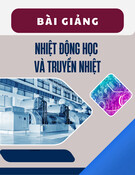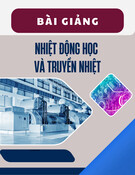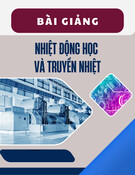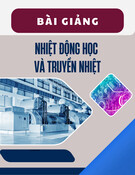
REVIEW ARTICLE
A nuclear owner/operator perspective on ways and means
for joint programming on predisposal activities
Michel Pieraccini
*
and Sylvain Granger
EDF Direction des Projets Déconstruction et Déchets (DP2D), 30 Avenue de Wagram, 75008 Paris, France
Received: 5 April 2019 / Accepted: 16 September 2019
Abstract. Nuclear decommissioning is a worldwide competitive market. It is also the main source of radioactive
waste from the nuclear energy field. In order to reduce the waste volume it is necessary to sort the actual
radioactive waste to be disposed of and to separate them from other materials that could be recycled. Since 2015,
Electricité de France (EDF) has gathered the waste management and dismantling (WM&D) projects, the
related competences and human resources in the WM&D field, in a dedicated directorate (DP2D) and a
company group called Cyclife (including waste treatment facilities). Taking into account the experience gained
by carrying out its own WM&D projects as well as contributing to international cooperation, EDF considers that
integrating collaborative research and development (R&D) on pre-disposal and waste management could be
carried out following four main objectives: (1) alignment of the application of regulatory frameworks through
appropriate definition of criteria and rules for radioactive waste to enable sensible worldwide comparison of
technics; (2) improvement of technical and organisational aspects of nuclear reactors decommissioning using a
demonstrator facility to be in operation, at first for graphite reactors, by 2022; (3) development of new
techniques to decontaminate/homogenize metallic materials through a dedicated recycling route. These
technics will be implemented in a new treatment facility foreseen to be available by 2030; and (4) increased
training of decommissioning operators with the help of new technologies. All these improvements are aiming,
beyond technical and experimental aspects, at reducing environmental impacts of nuclear activities as well as
preserving the radioactive disposal volumes, as they are considered by EDF as rare resources.
1 Introduction
As owner/operator of a nuclear fleet with the responsibility
of the dismantling of already shutdown NPPs, Electricité
de France (EDF) has acquired a sound and robust
experience in waste management and dismantling
(WM&D). Since 2015, EDF has created in the WM&D
field a dedicated directorate (DP2D) and its holding called
Cyclife. These new entities gather all corresponding
projects, all necessary human skills and resources as well
as technical means. Such new organisation enables DP2D
to define and make applied the WM&D strategy for the
entire EDF Group and its partners.
The main objective of this new organization is to
reinforce EDF’s capacity and leadership in this field. It will
allow the integration of R&D aspects such as decom-
missioning operators’training, testing of innovative
technologies (virtual reality, 3D simulation, remote
operations) and development of technical demonstrators.
Therefore, EDF intends to develop international collabo-
ration directly through industrial cooperation and through
participation in collaborative R&D projects. These
projects can be carried out under the umbrella of
international organisations such as the European Commis-
sion, OECD/NEA or IAEA, in which EDF already
contributes actively.
To define R&D programmes for improving radioactive
waste management during pre-disposal periods, it is
necessary to agree on the definition of “radioactive waste”
and the various current or potential sources. There is now a
global international agreement within the nuclear industry
to call “radioactive waste”the ultimate status of a
considered material that will require disposal. Thus, to
assess the status of waste, all materials to be generated by
nuclear activities should be precisely characterized and
sorted out in order to reduce significantly the amount of
actual radioactive waste to be disposed of.
The importance of reducing the radioactive waste
volume has increased over the last decade since repositories
are considered as rare resources to be preserved in order to
limit environmental impacts as much as possible. This care
about reducing waste volume is taken during the four steps
of the lifetime of a nuclear facility: design, construction,
operation and decommissioning. Then, as users of
radioactive disposals, nuclear operators take on their
*e-mail: michel.pieraccini@edf.fr
EPJ Nuclear Sci. Technol. 6, 20 (2020)
©M. Pieraccini and S. Granger, published by EDP Sciences, 2020
https://doi.org/10.1051/epjn/2019039
Nuclear
Sciences
& Technologies
Available online at:
https://www.epj-n.org
This is an Open Access article distributed under the terms of the Creative Commons Attribution License (https://creativecommons.org/licenses/by/4.0),
which permits unrestricted use, distribution, and reproduction in any medium, provided the original work is properly cited.

responsibility, by enhancing their expertise as well as
increasing their credibility by mastering techniques and
costs. In addition, they contribute to avoid spoiling
resources by disposing materials that can be reused or
recycled.
Defining relevant R&D programs in WM&D require
that all aspects of predisposal activities are properly
evaluated, considering the great diversity of type, nature
and activity of waste generated by decommissioning as well
as the involved quantities. Sufficient operational experi-
ence and feedback from existing practices help to identify
remaining needs, commonly shared at the European or the
international level.
2 Strategy on waste management
and decommissioning
2.1 Experience gained in performing decommissioning
on an industrial scale
In the last 10 years EDF has acquired experience in the
decommissioning of four different types of nuclear reactors.
This fruitful learning stage makes it possible to beneffrom
some lessons learned. They can be summarized as follow:
–For Pressurized Water Reactors (PWRs), which com-
pose the current French operating fleet, the feasibility of
the decommissioning process has already been demon-
strated. The focus is now on optimizing the sequence of
future operations and scenarios.
–For graphite reactors, the remote handling systems to
dismantle these huge reactors are still under develop-
ment. In parallel, the graphite waste management
remains a major issue. Considering the size and
complexity of this kind of reactors, dismantling design
and operation will lead to long timeframes.
–A sound experience in waste management driven
decommissioning is the cornerstone to successfully
perform the dismantling of a nuclear reactor.
France can rely on a complete and efficient radioactive
waste management system for nuclear waste produced
during decommissioning. However, this system could be
improved by addressing the issue of clearance levels to
allow the recycling of ingots produced after the melting of
very low-level radioactive metallic waste.
Specific care should be given to the use of terms for
decommissioning For instance, the term “immediate
dismantling”recommended by the IAEA, should not mean
that dismantling should be hurried, irrespective of
associated risks and costs, but that the decommissioning
of the nuclear plant should start soon after its shutdown.
This kind of misinterpretation could lead to counterpro-
ductive attitudes of counterparts including local stake-
holders.
2.2 Organisational issues
Taking into account the experience gained, EDF, in 2015,
decided to create and structure an entity devoted to
decommissioning and waste management with three main
objectives:
–support ongoing EDF dismantling worksites;
–prepare the decommissioning of the nuclear fleet in
operation;
–become a major actor in the WM&D market, which is
emerging but already highly competitive.
This restructuring has been progressively conducted in
three parallel phases:
–the creation of a dedicated directorate called DP2D
gathering all corresponding projects, resources and skills.
It reports directly to EDF Group Board;
–the creation of specialized subsidiaries providing waste
treatment services in order to optimise the sorting and
the volume of waste to be disposed of. In addition, it has
aimed at increasing EDF’s technical and financial
mastery for its own needs (as a responsible owner/
operator of a world nuclear fleet) or those of its partners/
customers (who trusts and relies on EDF capacities and
skills worldwide to preserve and develop their own
competitiveness);
–the establishment of industrial partnerships regarding
innovative and key technologies or targeted geographic
areas.
In order to take advantage of the ongoing development
of digital/numeric methods and techniques and to gain in
efficiency, a specific study has been initiated. The aim is to
analyse what would be the potential benefits of the
implementation of numerical techniques in the organiza-
tion model; would it be better to address the related topics
thanks to a dedicated structure (as it is currently
performed) or to consider this specificfield as a crosscutting
topic with its own strategy and associated business plan?
2.3 Regulatory framework
Currently, technological developments are due to EDF
engineering means and capacities, international coopera-
tion (IAEA, OECD/NEA and World Nuclear Association
(WNA)), feedback on various worksites as well as the R&D
research programmes. One of the lessons learned in this
particular field is that the efficiency of a technological
development depends not only on the techniques used or
the operator’s ability and mastery but also on regulatory
aspects.
Actually, the application of regulations, originally
initiated by international directives (IAEA, EC), can vary
from one country to another as they are adapted to local
considerations and national policies. This point is critical
for neighbouring countries as it may result in a risk of
confusion in the perception of the public. For instance,
some technique performed in one country could be
restricted or forbidden in a neighbouring country only
due to regulatory constraints, leading to confusion,
weakening nuclear operators’credibility as well as lowering
public acceptance.
For example, clearance levels, despite a global common
European regulation, are not systematically implemented
in national policies. This is an illustration of the national
policies heterogeneity, preventing from a more efficient
circular economy in waste management, at least at the
European Union level.
2 M. Pieraccini and S. Granger: EPJ Nuclear Sci. Technol. 6, 20 (2020)

It would, thus, be advantageous to align and harmonize
the application of the internationally agreed regulatory
basis. Such a framework shared and applied by all countries
with nuclear activities could enable an efficient comparison
of the efficiency, the suitability as well as the limits of
available techniques being operated in similar situations.
As a consequence, it will become easier to identify the
remaining needs of improvements as well as the necessary
R&D developments. In addition, a common regulatory
basis will help to qualify the decommissioning operators on
the common basis of an international shared assessment,
which is important as decommissioning is becoming an
international business.
2.4 Financial issues
Strategic considerations in WM&D and R&D have to take
into account the cost issues. This includes accurate cost
assessment, funding availability, on time, and the
associated mechanisms to provide funds.
Since 2006, France, like most other countries, has
developed and structured a rigorous and demanding
financial system, to guarantee future financing of WM&D
operations. French nuclear operators are on a regular basis
audited on their own financial capabilities. The audits
include the demonstration of the relevance of the dismantling
and waste treatment or conditioning scenarios, the efficiency
of the chosen processes as well as the operators’carefulness to
maintain them up to date along the years.
3 Ways and means for R&D on predisposal
activities
Mainly deduced from EDF observations throughout its
decades of experience as worldwide nuclear operator and its
strategies developed in WM&D, 4 ideas for international
cooperation are presented here after. They could be the
starting point for future R&D activities at European or
international levels in the frame of predisposal activities
development.
These preliminary ideas are not exhaustive, as decom-
missioning and waste management business, being a
competitive and emerging market, constitutes a continu-
ous field of innovation and improvements.
3.1 Alignment of the implementation of the regulatory
framework
Considering the long timeframe and the complexity of the
decommissioning activities, the research and innovation
effort makes sense if the application of the regulatory
framework is similar or at least coherent amongst the
countries. For instance, an appropriate definition of criteria
and rules for waste management routes may foster the
circular economy in material management at European and
international level.
Such improvements in regulations should be developed
with the support of IAEA and European Commission
through their Research and Innovation (R&I) programmes.
Creating exchange forums will help develop the sharing of
experiences and competences. Furthermore, it will enable
sensible and relevant comparison of techniques efficiency
being performed worldwide.
Alignment of decommissioning objectives, regulatory
framework and operating rules will help building confi-
dence among the stakeholders mitigating the risk of
confusion in population perception of facility dismantling
operations and waste management practices.
3.2 Improvement of technical and organizational
aspects of decommissioning graphite reactors
In line with its strategy, EDF has already launched the
Decommissioning Demonstrator project scheduled to be in
operation in 2022. Based on a modular design, the aim of
this demonstrator facility is first to check the feasibility of
decommissioning scenarios foreseen for graphite reactors.
In particular, it will help to improve safety as well as tools
and operators’efficiency thanks to an adequate training.
This will help to face unexpected situations that will
undoubtedly occur during real dismantling as none of the
graphite reactors have been designed to be decommis-
sioned. This demonstrator should therefore help to
strengthen the technical mastery at appropriate cost. This
new flexible facility will enable to test, improve and
implement innovative technologies while performing
decommissioning on site.
Beyond these objectives, the ambition of the Decom-
missioning Demonstrator project is to become an interna-
tional training centre for decommissioning operators.
Settled in Chinon (France), this location has the advantage
to be at nearly equal distance from most European graphite
reactors’locations. This demonstrator will allow operators
from foreign countries to share experiences and train
themselves on representative mock-ups in safe conditions.
The decommissioning of graphite reactors presents
specific characteristics and constraints in terms of scales,
dimensions and volumes of waste. Although these specific
characteristics are common for all reactors of this type, no
real set of decommissioning scenarios and tools are
commonly agreed.
Thus, the Decommissioning Demonstrator is a full scale
facility with a modular design, ensuring flexibility and
adaptability. It will allow the implementation of R&D
projects aimed at testing tools as well as training operators.
This facility is composed of two main parts: a 3D
simulation platform enabling digitalization and virtual
reality and a huge experimental hall with scale one
representative mock ups. The hall will serve to improve and
qualify innovative techniques, such as remote handling and
automated operations.
In addition, the experimental activities aim at improving
decommissioning operators’confidence and experience in
managing unexpected operational situation. They will also
help to determine accurately the types and quantities of
secondary induced waste produced in dismantling operation.
Moreover, complementing the decommissioning scenarios
assessment through this new angle will allow thereduction of
waste volume and consequently the limitation of the number
M. Pieraccini and S. Granger: EPJ Nuclear Sci. Technol. 6, 20 (2020) 3

of waste packages thanks to relevant compromise and choice
of tools.
Furthermore, the Decommissioning Demonstrator will
allow the development of innovative and applied R&D in
an international cooperation framework. The perspective
of implementing R&D based on real cases has already
drawn the attention and interests of the United Kingdom
and Spain, currently involved in graphite reactors decom-
missioning.
Supporting countries have been invited by EDF to
express their own needs regarding their own decommis-
sioning projects, not limited to graphite reactors, such that
they can be taken into account during the design of
representative mock-ups, operators training programs, or
other topics to be addressed with associated priorities.
The Decommissioning Demonstrator will apply for
European support through the 2019–2021 Euratom work
programme and in particular through the launch of a
specific European Joint Programme (EJP) comprising
R&D as well as training activities.
In addition, considering the expression of interest of
some members, the OECD/NEA Nuclear Innovative
Program (NI2050) has identified this future facility as
one of the 12 selected projects of interest in the nuclear
field. This OECD/NEA initiative is aiming at accelerating
R&D and market deployment of innovative nuclear fission
technologies to go with the necessary energy transition
towards a very low carbon energy mix.
Finally, the IAEA has recently expressed its willingness
to consider such project becoming a formation centre as
soon as its industrial objectives will be achieved.
Beyond improving dismantling operation and ongoing
waste management (in operation and in decommissioning),
the Decommissioning Demonstrator will positively direct
the future NPPs design and associated maintenance
operations whatever are their nuclear technologies.
3.3 Development of new techniques to
decontaminate/homogenize metallic materials
Currently, EDF considers the creation, in France, of a new
treatment facility to recycle metals. Based on the circular
economy principle, this new plant, foreseen to be available
by 2030, will comprise a melting oven and a foundry. The
new facility will allow preserving repository capacities
thanks to a significant reduction of volumes to be disposed
of. It will also preserve source of raw materials such as steel,
carbon and nickel.
At the early stage of the project, joint R&D
programmes are designed to establish a sound common
technical and regulatory basis to design processes that
could accommodate metallic waste coming from various
countries. In particular, emphasis will be given to study the
use of arc melting furnace technology to decontaminate/
homogenize metallic materials.
When operating, such unique facility could allow
centralizing and regulating metallic flows coming from
worldwide decommissioning worksites, particularly from
Europe and Asia. Metals could therefore be recycled and
further reused thanks to this new sustainable industrial
process.
3.4 Increased training of decommissioning operators
and implementation of robotics
A specific emphasis will be put on the need to increase
nuclear operators training using automated tools. The
training and qualification processes should be established
on the common basis of an international shared assessment
of current and future practices.
The operators’increased ability and effectiveness will
be obtained by strengthening their training on representa-
tive configurations and mock-ups specifically designed to
take into account the various nuclear technologies
constraints and requirements,
For example, the development of remote exoskeleton is
foreseen, as human skills and expertise appear irreplaceable
in some cases with high dose rate exposure. This R&D will
pave the way for progressively replacing operators by
machines without losing human know-how and mastery.
Such improvements and associated R&D could conse-
quently bring up safety and public acceptance as well as
increasing operators’efficiency.
In the future, an operator would be able, safely, from his
or her office or a representative mock-up, to operate
remotely a humanoid robot present on site. Thanks to 3D
and virtual reality, wearing its exoskeleton, the operator
will act as if he or she were really operating, adapting his
behaviour to the context.
Such evolution in working conditions could lead to
several advantages:
–improvements of the labour efficiency (up to ∼2 times),
increasing the time of work in conditions of ionized
radiation (reduction of the collective dose);
–reductions of personnel’s dose exposure;
–dismantlement of larger fragments without necessary
heavy handling/lifting means;
–easier worksite preparation with no (or less) need of time-
consuming (and waste-producing) preliminary decon-
tamination;
–reduction of the volumes of secondary induced waste
(work clothing, air locks, …), less washings leading to
fewer liquid effluents; and
–a drastic mitigation of the risk of injury, electric shock,
falling objects or falling from heights and their
consequences.
Last, but not least, it will keep operators’motivation at
high level and increase public confidence towards back-end
activities by use of cutting-edge technologies. This
innovative approach of performing nuclear decommission-
ing is also foreseen as a means to secure the roadmap by
accelerating cutting rates upgrading/modernizing scenari-
os and technologies. This last characteristic could foster the
attractiveness of back-end activities, particularly towards
young generations.
3.5 Intellectual property rights (IPR) issues
Although IPR is not the prime aim of this paper, it is clear
that in a highly technologic area like decommissioning it is
important to address IPR since the preliminary phases of
discussions, defining R&D programmes.
4 M. Pieraccini and S. Granger: EPJ Nuclear Sci. Technol. 6, 20 (2020)

Several ways exist to address these topics. They usually
depend on the level of involvement of each contributor, their
respective internal policies and their will to share their own
techniques/know-how aiming to improve them. EDF
currently implements various possible IPR schemes. All of
them lead to specific agreements, defining respective
contributors’commitments. The contractual framework
and in particular IPR rules in view of commercial
applications should be set specifically for each R&D project.
4 Conclusion
The worldwide experience gained from the last decade at
decommissioning worksites lead to a first conclusion: ways
and means of R&D implementation on dismantling
activities and waste management are strongly linked to
a suitable application of the regulatory framework.
A sound and efficient application will foster a circular
economy in materials, will help to establish a common basis
of comparison of techniques efficiency and decommissioning
operators’ability and will allow waste volume reduction.
This first point is important for identifying the actual
remaining lacks and needs of knowledge and consequently
the associated R&D developments requirements.
The second point is to put in coherence at the
International level operators’training rules (up to their
certification). This goal could be achieved on one hand by
the sharing of experiences through international cooper-
ation and, on the other hand, by the use of experimental
demonstrators equipped with representative mock-ups.
These experimental demonstrators will help to adapt
already existing tools or to identify and implement the
required applicable pragmatic innovations. It will
increase the efficiency of operators and techniques,
mitigating risks (dose exposure, human intervention,
secondary induced waste (clothing, wash liquid efflu-
ents)) and associated costs while securing the global
decommissioning roadmap.
The development of sustainable techniques may have a
positive impact on public acceptance as well as stake-
holders’confidence.
Achieving these objectives will improve future NPPs’
design in order to ease future decommissioning operations
and thus, strengthening the nuclear industry credibility.
International cooperation, e.g. through the support of
the European R&D work programmes in WM&D will
help to reach a global commitment in a sustainable,
internationally shared waste management policy and
practices.
Cite this article as: Michel Pieraccini and Sylvain Granger, A nuclear owner/operator perspective on ways and means for joint
programming on predisposal activities, EPJ Nuclear Sci. Technol. 6, 20 (2020)
M. Pieraccini and S. Granger: EPJ Nuclear Sci. Technol. 6, 20 (2020) 5


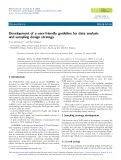
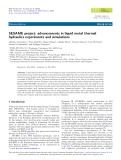
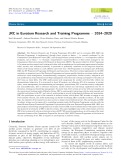


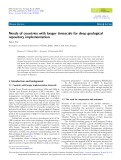

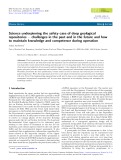
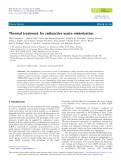






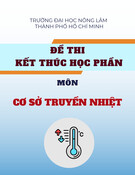

![Ngân hàng trắc nghiệm Kỹ thuật lạnh ứng dụng: Đề cương [chuẩn nhất]](https://cdn.tailieu.vn/images/document/thumbnail/2025/20251007/kimphuong1001/135x160/25391759827353.jpg)
